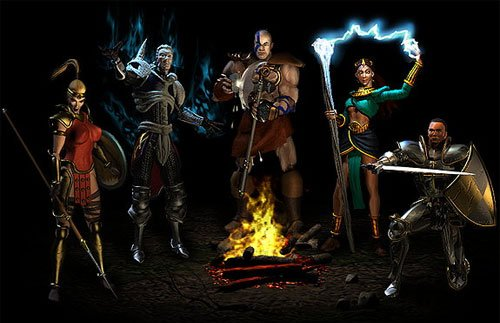Diablo II
Diablo II, sequel to the game Diablo, is a dark fantasy-themed action role-playing game in a hack and slash and "dungeon roaming" style. It was released for Microsoft Windows and Mac OS in 2000 by Blizzard Entertainment, and was developed by Blizzard North.
By April 2001, Diablo II had become one of the most popular online games ever.needed Major factors that contributed to Diablo II's success include what fans found to be addictive hack and slash gameplay and free access to Battle.net.needed Diablo II may be played as a single player game, multi-player via a LAN, or multi-player via Battle.net, with the latter being the most popular.needed
The game was conceptualized and designed by Stieg Hedlund, with Blizzard North founders David Brevik, Max and Eric Shaefer acting as Project Leads for the other disciplines (Engineering, Character Art and Environment Art, respectively). The main production roles were handled by Matthew Householder and Bill Roper.
An expansion to Diablo II, Diablo II: Lord of Destruction, was released in 2001, and is now at version 1.12a. A sequel, Diablo III, was announced on June 28, 2008.
Gameplay

The five available character classes in Diablo II: Amazon, Necromancer, Barbarian, Sorceress and Paladin
Diablo II emphasizes combat, and randomly generates many monster properties, level lay-outs and item drops. Most of the maps themselves are randomly generated. In single player mode, the map is randomly generated but locks the setting thereafter; in multiplayer mode, it resets every time the game is restarted.
Diablo II allows the player to choose between five different character classes: Necromancer, Amazon, Barbarian, Sorceress, and Paladin. Each character has different strengths and weaknesses and sets of skills to choose from, as well as varying beginning attributes.
In addition to the four acts there are also three difficulty levels: Normal, Nightmare, and Hell. A character must complete these difficulty levels in order; only once a character completes Normal difficulty can that character play at Nightmare difficulty, and similarly for Hell difficulty. Each difficulty is a greater challenge than the last, with such features as increased creature difficulty, experience penalties upon death, and other challenges. A character retains all abilities, equipment, etc, between difficulties, and may return to earlier difficulties at any time. Upon completion of the game in normal difficulty, a player may create a hardcore character. While for normal players the game doesn't end when they die (as they are resurrected into that act's home town), the game ends when a hardcore character is killed.
Diablo II also has a number of other features that enhance gameplay. The player has the option of hiring one of several computer-controlled mercenaries, that follow the player and attack nearby enemies. On occasion, the player might find a rare, valuable item, or one that is part of a set that becomes more powerful when the entire set is collected. Items can be customized using sockets and gems, or transmuted into different items using the Horadric Cube.
| Allakhazam credits this article at Wikipedia for some of the info in this article. Licensed under the GFDL. |
|
